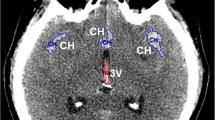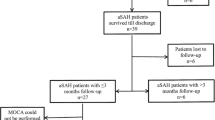Abstract
Background
Early brain injury (EBI) following aneurysmal subarachnoid hemorrhage (SAH) is an important predictor of poor functional outcome, yet the underlying mechanism is not well understood. Animal studies suggest that platelet activation and inflammation with subsequent microthrombosis and ischemia may be a mechanism of EBI.
Methods
A prospective, hypothesis-driven study of spontaneous, SAH patients and controls was conducted. Platelet activation [thromboelastography maximum amplitude (MA)] and inflammation [C-reactive protein (CRP)] were measured serially over time during the first 72 h following SAH onset. Platelet activation and inflammatory markers were compared between controls and SAH patients with mild [Hunt–Hess (HH) 1–3] versus severe (HH 4–5) EBI. The association of these biomarkers with 3-month functional outcomes was evaluated.
Results
We enrolled 127 patients (106 SAH; 21 controls). Platelet activation and CRP increased incrementally with worse EBI/HH grade, and both increased over 72 h (all P < 0.01). Both were higher in severe versus mild EBI (MA 68.9 vs. 64.8 mm, P = 0.001; CRP 12.5 vs. 1.5 mg/L, P = 0.003) and compared to controls (both P < 0.003). Patients with delayed cerebral ischemia (DCI) had more platelet activation (66.6 vs. 64.9 in those without DCI, P = 0.02) within 72 h of ictus. At 3 months, death or severe disability was more likely with higher levels of platelet activation (mRS4–6 OR 1.18, 95 % CI 1.05–1.32, P = 0.007) and CRP (mRS4–6 OR 1.02, 95 % CI 1.00–1.03, P = 0.041).
Conclusions
Platelet activation and inflammation occur acutely after SAH and are associated with worse EBI, DCI and poor 3-month functional outcomes. These markers may provide insight into the mechanism of EBI following SAH.



Similar content being viewed by others
References
Frontera JA, Fernandez A, Schmidt JM, et al. Defining vasospasm after subarachnoid hemorrhage: what is the most clinically relevant definition? Stroke. 2009;40:1963–8.
Wartenberg KE, Schmidt JM, Claassen J, et al. Impact of medical complications on outcome after subarachnoid hemorrhage. Crit Care Med. 2006;34:617–23 (quiz 24).
Grote E, Hassler W. The critical first minutes after subarachnoid hemorrhage. Neurosurgery. 1988;22:654–61.
Sehba FA, Bederson JB. Mechanisms of acute brain injury after subarachnoid hemorrhage. Neurol Res. 2006;28:381–98.
Sehba FA, Mostafa G, Friedrich V Jr, Bederson JB. Acute microvascular platelet aggregation after subarachnoid hemorrhage. J Neurosurg. 2005;102:1094–100.
Friedrich V, Flores R, Muller A, Bi W, Peerschke EI, Sehba FA. Reduction of neutrophil activity decreases early microvascular injury after subarachnoid haemorrhage. J Neuroinflamm. 2011;8:103.
Sehba FA, Friedrich V. Early micro vascular changes after subarachnoid hemorrhage. Acta Neurochir Suppl. 2011;110:49–55.
Smyth SS, McEver RP, Weyrich AS, et al. Platelet functions beyond hemostasis. J Thromb Haemost. 2009;7:1759–66.
Renesto P, Chignard M. Tumor necrosis factor-alpha enhances platelet activation via cathepsin G released from neutrophils. J Immunol. 1991;146:2305–9.
Friedrich V, Flores R, Muller A, Sehba FA. Luminal platelet aggregates in functional deficits in parenchymal vessels after subarachnoid hemorrhage. Brain Res. 2010;1354:179–87.
Friedrich V, Flores R, Muller A, Sehba FA. Escape of intraluminal platelets into brain parenchyma after subarachnoid hemorrhage. Neuroscience. 2010;165:968–75.
Frontera JA, Aledort L, Gordon E, et al. Early platelet activation, inflammation and acute brain injury after a subarachnoid hemorrhage: a pilot study. J Thromb Haemost. 2012;10:711–3.
Craft RM, Chavez JJ, Bresee SJ, Wortham DC, Cohen E, Carroll RC. A novel modification of the thrombelastograph assay, isolating platelet function, correlates with optical platelet aggregation. J Lab Clin Med. 2004;143:301–9.
Swallow RA, Agarwala RA, Dawkins KD, Curzen NP. Thromboelastography: potential bedside tool to assess the effects of antiplatelet therapy? Platelets. 2006;17:385–92.
Sambu N, Hobson A, Curzen N. “Short” thrombelastography as a test of platelet reactivity in response to antiplatelet therapy: validation and reproducibility. Platelets. 2011;22:210–6.
Khurana S, Mattson JC, Westley S, O’Neill WW, Timmis GC, Safian RD. Monitoring platelet glycoprotein IIb/IIIa-fibrin interaction with tissue factor-activated thromboelastography. J Lab Clin Med. 1997;130:401–11.
Hunt WE, Hess RM. Surgical risk as related to time of intervention in the repair of intracranial aneurysms. J Neurosurg. 1968;28:14–20.
Oshiro EM, Walter KA, Piantadosi S, Witham TF, Tamargo RJ. A new subarachnoid hemorrhage grading system based on the Glasgow Coma Scale: a comparison with the Hunt and Hess and World Federation of Neurological Surgeons Scales in a clinical series. Neurosurgery. 1997;41:140–7 (discussion 7–8).
Teasdale G, Jennett B. Assessment and prognosis of coma after head injury. Acta Neurochir (Wien). 1976;34:45–55.
Brott T, Adams HP Jr, Olinger CP, et al. Measurements of acute cerebral infarction: a clinical examination scale. Stroke. 1989;20:864–70.
Rankin J. Cerebral vascular accidents in patients over the age of 60. II. Prognosis. Scott Med J. 1957;2:200–15.
van Swieten JC, Koudstaal PJ, Visser MC, Schouten HJ, van Gijn J. Interobserver agreement for the assessment of handicap in stroke patients. Stroke. 1988;19:604–7.
Sehba FA. Rat endovascular perforation model. Transl Stroke Res. 2014;5:660–8.
Pisapia JM, Xu X, Kelly J, et al. Microthrombosis after experimental subarachnoid hemorrhage: time course and effect of red blood cell-bound thrombin-activated pro-urokinase and clazosentan. Exp Neurol. 2012;233:357–63.
Friedrich V, Flores R, Sehba FA. Cell death starts early after subarachnoid hemorrhage. Neurosci Lett. 2012;512:6–11.
Frontera JA, Ahmed W, Zach V, et al. Acute ischaemia after subarachnoid haemorrhage, relationship with early brain injury and impact on outcome: a prospective quantitative MRI study. J Neurol Neurosurg Psychiatry. 2015;86:71–8.
Hadeishi H, Suzuki A, Yasui N, Hatazawa J, Shimosegawa E. Diffusion-weighted magnetic resonance imaging in patients with subarachnoid hemorrhage. Neurosurgery. 2002;50:741–7 (discussion 7–8).
Sato K, Shimizu H, Fujimura M, Inoue T, Matsumoto Y, Tominaga T. Acute-stage diffusion-weighted magnetic resonance imaging for predicting outcome of poor-grade aneurysmal subarachnoid hemorrhage. J Cereb Blood Flow Metab. 2010;30:1110–20.
Stein SC, Browne KD, Chen XH, Smith DH, Graham DI. Thromboembolism and delayed cerebral ischemia after subarachnoid hemorrhage: an autopsy study. Neurosurgery. 2006;59:781–7 (discussion 7–8).
Sehba FA, Mostafa G, Knopman J, Friedrich V Jr, Bederson JB. Acute alterations in microvascular basal lamina after subarachnoid hemorrhage. J Neurosurg. 2004;101:633–40.
Hussain S, Barbarite E, Chaudhry NS, et al. Search for biomarkers of intracranial aneurysms: a systematic review. World Neurosurg. 2015;84:1473–83.
Chen S, Feng H, Sherchan P, et al. Controversies and evolving new mechanisms in subarachnoid hemorrhage. Prog Neurobiol. 2014;115:64–91.
Boluijt J, Meijers JC, Rinkel GJ, Vergouwen MD. Hemostasis and fibrinolysis in delayed cerebral ischemia after aneurysmal subarachnoid hemorrhage: a systematic review. J Cereb Blood Flow Metab. 2015;35:724–33.
Frontera JA. Clinical trials in cardiac arrest and subarachnoid hemorrhage: lessons from the past and ideas for the future. Stroke Res Treat. 2013;2013:263974.
Vergouwen MD, Bakhtiari K, van Geloven N, Vermeulen M, Roos YB, Meijers JC. Reduced ADAMTS13 activity in delayed cerebral ischemia after aneurysmal subarachnoid hemorrhage. J Cereb Blood Flow Metab. 2009;29:1734–41.
Suzuki S, Suzuki M, Iwabuchi T, Kamata Y. Role of multiple cerebral microthrombosis in symptomatic cerebral vasospasm: with a case report. Neurosurgery. 1983;13:199–203.
Suzuki S, Kimura M, Souma M, Ohkima H, Shimizu T, Iwabuchi T. Cerebral microthrombosis in symptomatic cerebral vasospasm—a quantitative histological study in autopsy cases. Neurol Med Chir. 1990;30:309–16.
Chou SH, Feske SK, Atherton J, et al. Early elevation of serum tumor necrosis factor-alpha is associated with poor outcome in subarachnoid hemorrhage. J Invest Med. 2012;60:1054–8.
Lackner P, Dietmann A, Beer R, et al. Cellular microparticles as a marker for cerebral vasospasm in spontaneous subarachnoid hemorrhage. Stroke. 2010;41:2353–7.
Chou SH, Feske SK, Simmons SL, et al. Elevated peripheral neutrophils and matrix metalloproteinase 9 as biomarkers of functional outcome following subarachnoid hemorrhage. Transl Stroke Res. 2011;2:600–7.
Ishikawa M, Kusaka G, Yamaguchi N, et al. Platelet and leukocyte adhesion in the microvasculature at the cerebral surface immediately after subarachnoid hemorrhage. Neurosurgery. 2009;64:546–53 (discussion 53–54).
van den Bergh WM, MASH Study Group, Algra A, et al. Randomized controlled trial of acetylsalicylic acid in aneurysmal subarachnoid hemorrhage: the MASH Study. Stroke. 2006;37:2326–30.
van den Bergh WM, Kerr RS, Algra A, Rinkel GJ, Molyneux AJ, International Subarachnoid Aneurysm Trial Collaborative Group. Effect of antiplatelet therapy for endovascular coiling in aneurysmal subarachnoid hemorrhage. Stroke. 2009;40:1969–72.
Gross BA, Rosalind Lai PM, Frerichs KU, Du R. Aspirin and aneurysmal subarachnoid hemorrhage. World Neurosurg. 2014;82:1127–30.
Dorhout Mees SM, Rinkel GJ, Hop JW, Algra A, van Gijn J. Antiplatelet therapy in aneurysmal subarachnoid hemorrhage: a systematic review. Stroke. 2003;34:2285–9.
Acknowledgments
Dr. Frontera received funding for this project from the American Heart Association (11CRP5270003) and the Research Program Committee of the Cleveland Clinic (RPC # 2013-1014).
Author contributions
J.A. Frontera was responsible for study design, collecting, analyzing and interpreting data, writing the manuscript, and final approval of the version to be published. J.J. Provencio was responsible for interpreting the data, revising the intellectual content, and final approval of the version to be published. F.A. Sehba was responsible for study design, analyzing and interpreting data, revising the intellectual content and final approval of the version to be published. T.M. McIntyre was responsible for revising the intellectual content, and final approval of the version to be published. A.S. Nowacki was responsible for analyzing and interpreting data and final approval of the version to be published. E. Gordon was responsible for collecting data and final approval of the version to be published. J.M. Weimer was responsible for collecting data and final approval of the version to be published. L. Aledort was responsible for study design, analyzing and interpreting data, revising the intellectual content, and final approval of the version to be published.
Author information
Authors and Affiliations
Corresponding author
Ethics declarations
Conflict of interest
None.
Electronic supplementary material
Below is the link to the electronic supplementary materials.
12028_2016_292_MOESM1_ESM.tif
Supplementary Figure 1. Platelet activation, C-reactive protein (CRP) in jugular and peripheral venous blood over the first 72 hours following aneurysm rupture. Whisker bars represent the standard error of the mean. MA = maximum amplitude, SAH = subarachnoid hemorrhage (TIF 71 kb)
Rights and permissions
About this article
Cite this article
Frontera, J.A., Provencio, J.J., Sehba, F.A. et al. The Role of Platelet Activation and Inflammation in Early Brain Injury Following Subarachnoid Hemorrhage. Neurocrit Care 26, 48–57 (2017). https://doi.org/10.1007/s12028-016-0292-4
Published:
Issue Date:
DOI: https://doi.org/10.1007/s12028-016-0292-4




